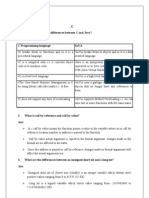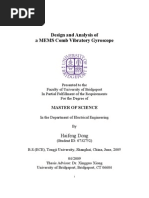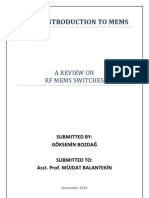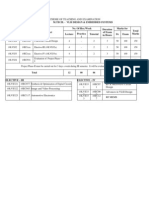Design of Phase Shifter Packaging Based On Through Glass Via (TGV) Interposer
Design of Phase Shifter Packaging Based On Through Glass Via (TGV) Interposer
Uploaded by
Navin Andrew PrinceCopyright:
Available Formats
Design of Phase Shifter Packaging Based On Through Glass Via (TGV) Interposer
Design of Phase Shifter Packaging Based On Through Glass Via (TGV) Interposer
Uploaded by
Navin Andrew PrinceOriginal Title
Copyright
Available Formats
Share this document
Did you find this document useful?
Is this content inappropriate?
Copyright:
Available Formats
Design of Phase Shifter Packaging Based On Through Glass Via (TGV) Interposer
Design of Phase Shifter Packaging Based On Through Glass Via (TGV) Interposer
Uploaded by
Navin Andrew PrinceCopyright:
Available Formats
DcsignufRF MEMS phascshihcrpackaginghascdunthruughglassvia(TGV) intcrpuscr
Xiaofeng Sun, Yu Sun, Jing Zhang, Daquan Yu, Lixi Wan
Institute of Microelectronics, Chinese Academy of Sciences
No. 3, BeiTuCheng West Road, Chaoyang district, Beijing, 100029, PR China
Email: sunxiaofeng@ime.ac.cn
PDSIaC
Glass has good electrical, optical and mechanical
properties as a substrate for SiP application . Through glass
via (TGV) interposer technology can avoid complex
fabrication processes and the using of expensive equipments
comparing with through silicon via(TSV). In addition, it can
lower the cost and enhance electrical performance as weil as
reliability of the electronic package. In this paper, a kind of
TGV wafer with tungsten(W) vias is introduced and its
performance is simulated. Using this kind of TGV interposer,
a one-bit MEMS switched-line phase shifer and its
package are designed.
1 HI0UHC0H
MEMS phase shifer is an ideal component in moder
communication and radar system, which has low cost, smaller
volume and low power consumption. Because of its
complexity and uniqueness, there is few notable breakthrough
in recent years in the feld of MEMS device packaging,
which therefore limits its wide usage [I].
Glass is an excellent material for packaging because of its
weil matched coeffcient of thermal expansion(CTE) to
silicon, superior electrical insulation, low dielectric constant,
high optical transparency, great hermeticity, low warping and
resistance to corosion[2]. It is suitable for optical devices,
and microwave devices and MEMS packaging. Glass
packaging is now widely studied in electrical packaging [3].
However, the glass process is not compatible with tradition al
semiconductor process, which brings diffculties to glass
three-dimensional packaging. It is diffcult to make vertical
vias through glass wafer through wet etching, dry etching or
laser drilling. Fulflling the vias with metal is also a challenge.
In this paper, a new packaging scheme of MEMS
phase shifer is introduced using our through glass via (TGV)
interposer. Compared with through silicon via (TSV)
interposer, this TGV interposer technology can avoid complex
fabrication processes and consequently it can lower the cost.
Z cS_H aHU SHHa0H
We have fabricated 4 inch TGV wafer with about 2000
tungsten pins, which is shown in Fig.l. The wafer use
borosilicate glass as substrate and tungsten was flled in vias.
The dielectric constant is 4.6 and the loss angle tangent (tgo)
is 37x 10-
6
, which is an excellent property for device
packaging. The diameter of tungsten pin is about 100/m and
the pitch is about 400/m. The coefcient of thermal
expansion(CTE) of the glass substrate is about 3.3 1O-
6
/k
and it is matched with silicon and suitable for bonding with
silicon.
Fig.1 Photograph of TGV wafer
Z.1 bHHa0H 01LN
The performance of TGV was simulated using fnite
element fll-wave method and the simulation model is shown
in Fig.2. Two segments of CPW were connected by three
tungsten pins and the two segments of CPW are on the
diferent side of the TGV wafer.
Fig.2 TGV simulation model
The simulated results are shown in Fig.3 and Fig.4. Fig.3
shows the insertion loss and retur loss with different radius of
tungsten pins. In the simulation model only the radius changes
fom 25 to 125/m. It is observed that the insertion loss
increased with the radius, while the retur loss changes in the
opposite way.
2012 International Conference on Electronic Packaging Technology High Density Packaging
978-1-4673-1681-1112/$31.00 m012 IEEE
808
"
t_1t
4'gb1L Wn
&Tl: |=T
*9\WM`W|%
"
^@MWT
=- ==- =
Z
W1W
(a)
(b)
Cm
!ATl
d'JWJ<'
(@ _ _ t_ 1!g
+_[1]
og w' h 'O
W.!,T1|
M\ M
o1mm1t' m2`
Fig.3 Simulated results of TGV with different radius: (a)
insertion loss, (b) retu loss
Fig.4 shows the insertion loss and retur loss with different
length of tungsten pins. From Fig.4 it can be seen that the
longer tungsten pins, the higher insertion loss and the lower
retur loss were obtained.
_:_11)
__I_T1)
m
&_1_T11
=- _ A_\_T11
_1_1!)
A_1_T11
lA\,T\1
ZV
V
(a)
(b)
~t 7t
t
___1.mQ!l
__ttv
Fig.4 Simulated results of TGV with different length: (a)
insertion loss, (b) retur loss
Z.Z cS_H 01 DDbgHaScSHcI gaCKa_c
Here a one-bit RF MEMS switched-line phase shifer was
designed which employs CPW as transmission line and three
shunt capacitive-switches. The TGV wafer is used as substrate
ofRF MEMS phase shifer. The schematic is shown in Fig.5.
(a)
(b)
Fig.5 Schematic of one-bit RF MEMS switched-line phase
shifer: (a) top view, (b) back view
The phase shifer was built on the one side (top side) of
TGV wafer and the input and output pad of RF signal was
fabricated on the other side (back side) of the TGV wafer,
which is shown in Fig.5. They are connected through tungsten
pins. Also the MEMS switches are driven through tungsten
pins form back side.
The phase shifer in degree is given by:
2"
-(/2 -11) P(12 -11)
Ag
Where Ag is wavelength of RF signal, I1 and 12 are the
lengths of reference line and delay line respectively.
The RF MEMS phase shifer can be fabricated by a
multilayer UV-LIGA process. Afer the phase shifer was
fmished, it can be bonded with a silicon cap through anodic
bon ding.
2012 International Conference on Electronic Packaging Technology High Density Packaging 809
Fig.6 Packaging ofRF MEMS phase shifer
L0HCHS0H
A kind of W flled TGV wafer is introduced and its RF
performance is simulated. Based on the TGV interposer,
packaging of a one-bit RF MEMS switched-line phase shifer
is designed. It can easily realize the RF signal in and out
through the package.
PCKH0WcU_HcH
This work was fnancially supported by National S&T
Major Project with the contract NO. 2009ZX02038-003.
Daquan Yu also appreciates the support fom the 100 Talents
Program of The Chinese Academy of Sciences.
c1cIcHCcS
. Ken Gilleo, MEMS/MoMES packaging, McGraw-Hill
(New York, 2005), pp. 65-67.
2. Yu Sun, Daquan Yu, et al. "Development of Through
Glass Tungsten Via Interconnect for 3D MEMS
Packaging", 2611 1/h L/ec/oaics Packagiag
Iechao/og:oa/eeace.pp.774-776.
3. Cui, X. Y., D. Bhatt, et al. "Glass as a Substrate for High
Density Electrical Interconnect," 266 16/h L/ec/oaics
PackagiagIechao/og:oa/eeace.Vols 1-3, pp.12-17.
2012 International Conference on Electronic Packaging Technology High Density Packaging 810
You might also like
- A Brief Introduction To MEMS and NEMSDocument29 pagesA Brief Introduction To MEMS and NEMS9894786946No ratings yet
- JBadding Optoelectronics FiberDocument9 pagesJBadding Optoelectronics FiberFISORGNo ratings yet
- Sic Mos Trench SJ 122802Document9 pagesSic Mos Trench SJ 122802terry chenNo ratings yet
- Athermal Polysilicon Mach-Zehnder Interferometer in Bulk CMOSDocument4 pagesAthermal Polysilicon Mach-Zehnder Interferometer in Bulk CMOSPaola GongoraNo ratings yet
- Sige Optoelectronic Metal-Oxide Semiconductor Field-Effect TransistorDocument3 pagesSige Optoelectronic Metal-Oxide Semiconductor Field-Effect TransistorPriyanka SethiNo ratings yet
- Optics, Modules, and Lenses: 5.1 Planar Lightwave CircuitsDocument30 pagesOptics, Modules, and Lenses: 5.1 Planar Lightwave CircuitsLauren StevensonNo ratings yet
- Ieps 1Document10 pagesIeps 1Sundaravathanan ChellappanNo ratings yet
- Future MOSFET Devices Using High-K (TiO2) DielectricDocument6 pagesFuture MOSFET Devices Using High-K (TiO2) DielectricIJRASETPublicationsNo ratings yet
- 31 - 44 - Single-Layer Substrate Integrated Waveguide Directional CouplersDocument6 pages31 - 44 - Single-Layer Substrate Integrated Waveguide Directional CouplersapertaputraNo ratings yet
- 3d Floorplanning - ReviewPaperDocument6 pages3d Floorplanning - ReviewPaperMayank ChoudharyNo ratings yet
- Application in Mobile CommDocument4 pagesApplication in Mobile CommAnandita MalikNo ratings yet
- Thesis Substrate Integrated WaveguideDocument4 pagesThesis Substrate Integrated Waveguideafknlbbnf100% (2)
- Millimeter-Wave Silicon-on-Glass Integrated Tapered AntennaDocument4 pagesMillimeter-Wave Silicon-on-Glass Integrated Tapered AntennaAbdul AzizNo ratings yet
- ao-58-30-8221Document6 pagesao-58-30-8221yiwang.liu001No ratings yet
- xiao2015Document11 pagesxiao2015ynader2001No ratings yet
- Accepted Manuscript: Materials LettersDocument8 pagesAccepted Manuscript: Materials Lettersالعلم نور والجهل ظلامNo ratings yet
- QTR Ch8Document6 pagesQTR Ch8Lim Chia SeangNo ratings yet
- Exploring Strategies To Contact 3D NanoDocument9 pagesExploring Strategies To Contact 3D NanoMatteo LorenzoniNo ratings yet
- Green Laser Crystallized Poly-Si Thin-Film Transistor and CMOS Inverter Using Hfo2-Zro2 Superlattice Gate Insulator and Microwave Annealing For BEOL ApplicationsDocument2 pagesGreen Laser Crystallized Poly-Si Thin-Film Transistor and CMOS Inverter Using Hfo2-Zro2 Superlattice Gate Insulator and Microwave Annealing For BEOL Applicationsaanya.2129No ratings yet
- SCOD Unit FirstDocument34 pagesSCOD Unit Firsttkartikeya44No ratings yet
- Numerical Investigation and Comparison With Experimental Characterisation of Side Gate P-Type Junctionless Silicon Transistor in Pinch-Off StateDocument5 pagesNumerical Investigation and Comparison With Experimental Characterisation of Side Gate P-Type Junctionless Silicon Transistor in Pinch-Off Statesaeid59No ratings yet
- Ecscrm PaperDocument7 pagesEcscrm Papernijob29704No ratings yet
- Technicalarticles Mmwave Siw FilterDocument7 pagesTechnicalarticles Mmwave Siw FilterVikas SinglaNo ratings yet
- LTCC Based Sensors and MicrosystemsDocument11 pagesLTCC Based Sensors and MicrosystemsceroycesarNo ratings yet
- Silicon-Nanowire Mosfets Cmos Compatible Gate-All-Around VerticalDocument4 pagesSilicon-Nanowire Mosfets Cmos Compatible Gate-All-Around VerticalMas MoNo ratings yet
- How To Bring Nanophotonics To Application - Silicon Photonics PackagingDocument9 pagesHow To Bring Nanophotonics To Application - Silicon Photonics PackagingTony JosephNo ratings yet
- AC Loss Analysis of Striated HTS Compact Cables For Low Loss Cable DesignDocument4 pagesAC Loss Analysis of Striated HTS Compact Cables For Low Loss Cable DesignCristian Daniel Antilao PizarroNo ratings yet
- Silicon Vertically Integrated Nanowire Field Effect TransistorsDocument5 pagesSilicon Vertically Integrated Nanowire Field Effect TransistorsMas MoNo ratings yet
- 1.2_kV_4H-SiC_VDMOSFETs_with_Si-implanted_Surface_Performance_Enhancement_and_Reliability_EvaluationDocument4 pages1.2_kV_4H-SiC_VDMOSFETs_with_Si-implanted_Surface_Performance_Enhancement_and_Reliability_Evaluation1050675843zxdNo ratings yet
- Design and Analysis of A Novel Low Actuated Voltage RF MEMS Shunt Capacitive SwitchDocument5 pagesDesign and Analysis of A Novel Low Actuated Voltage RF MEMS Shunt Capacitive SwitchiaetsdiaetsdNo ratings yet
- Flight Vehicle Design Laboratory 10Document4 pagesFlight Vehicle Design Laboratory 10chikkuNo ratings yet
- Effect of Thickness Variation On Electrical Characteristics of Single & Dual Gate Organic Thin Film TransistorsDocument5 pagesEffect of Thickness Variation On Electrical Characteristics of Single & Dual Gate Organic Thin Film TransistorsIRJIENo ratings yet
- On The Design of RF Spiral Inductors On Silicon: Joachim N. Burghartz, Fellow, IEEE, and Behzad RejaeiDocument12 pagesOn The Design of RF Spiral Inductors On Silicon: Joachim N. Burghartz, Fellow, IEEE, and Behzad RejaeilindaNo ratings yet
- Liu 2013Document5 pagesLiu 2013dhook_mmmNo ratings yet
- Towards An Optical FPGA - Programmable Silicon Photonic CircuitsDocument19 pagesTowards An Optical FPGA - Programmable Silicon Photonic CircuitsMurat Yasar ERTASNo ratings yet
- Design and Analysis of Double Gate MOSFET Devices Using High-K DielectricDocument8 pagesDesign and Analysis of Double Gate MOSFET Devices Using High-K Dielectricabhimanyu_bhate6264No ratings yet
- Characteristics of Gate-All-Around Junctionless Polysilicon Nanowire Transistors With Twin 20-nm GatesDocument5 pagesCharacteristics of Gate-All-Around Junctionless Polysilicon Nanowire Transistors With Twin 20-nm GatesSikender Nawaz Shafi BhatNo ratings yet
- Georgia - 3D Toroidal Air-Core Inductor With Through-Wafer Interconnect For On-Chip IntegrationDocument4 pagesGeorgia - 3D Toroidal Air-Core Inductor With Through-Wafer Interconnect For On-Chip IntegrationChandra ShettyNo ratings yet
- Chung et al. - Monolayer-MoS2 Stacked Nanosheet Channel with C-tyDocument4 pagesChung et al. - Monolayer-MoS2 Stacked Nanosheet Channel with C-tysunzhengstuNo ratings yet
- Elastomeric Electronics: A Microfluidic Approach: Shi ChengDocument20 pagesElastomeric Electronics: A Microfluidic Approach: Shi ChengVignesh RamakrishnanNo ratings yet
- VLSI Fabrication and CharacterizationDocument40 pagesVLSI Fabrication and CharacterizationKarthik RamasamyNo ratings yet
- Experimental Study On Wavelength Tunability of All-Optical Flip-Flop Based On Multimode-Interference Bistable Laser DiodeDocument9 pagesExperimental Study On Wavelength Tunability of All-Optical Flip-Flop Based On Multimode-Interference Bistable Laser DiodeAlonso YapoNo ratings yet
- Fabricación de Uniones Al-AlOx-Al Josephson Sobre Sustratos de Silicio y Zafiro Utilizando Una Técnica de Revelado en FríoDocument6 pagesFabricación de Uniones Al-AlOx-Al Josephson Sobre Sustratos de Silicio y Zafiro Utilizando Una Técnica de Revelado en FríojamesNo ratings yet
- 2023DN_Ngo_MOCVDgrownGaOpowerMOSFETsonSapphire (1)Document7 pages2023DN_Ngo_MOCVDgrownGaOpowerMOSFETsonSapphire (1)bngoc.st11No ratings yet
- MagLatt PRA 4Document11 pagesMagLatt PRA 4TienTranNo ratings yet
- KOTURA Fundamentals of Silicon Photonic DevicesDocument7 pagesKOTURA Fundamentals of Silicon Photonic DevicesDivya JaggyaNo ratings yet
- A D-Band Self-Packaged Low Loss Grounded Coplanar Waveguide To Rectangular Waveguide Transition With Silicon-Based Air Cavity-Backed StructureDocument10 pagesA D-Band Self-Packaged Low Loss Grounded Coplanar Waveguide To Rectangular Waveguide Transition With Silicon-Based Air Cavity-Backed StructuresneepweepNo ratings yet
- Broadband_4_times_4_Nonblocking_Silicon_Electrooptic_Switches_Based_on_MachZehnder_InterferometersDocument9 pagesBroadband_4_times_4_Nonblocking_Silicon_Electrooptic_Switches_Based_on_MachZehnder_InterferometersAvijitchatterjeeNo ratings yet
- 1556-276X-9-695Document5 pages1556-276X-9-695imanjebeliniaNo ratings yet
- Thickness-Dependent Thermal Resistance of A Transparent Glass Heater With A Single-Walled Carbon Nanotube CoatingDocument7 pagesThickness-Dependent Thermal Resistance of A Transparent Glass Heater With A Single-Walled Carbon Nanotube CoatingFernando DíazNo ratings yet
- Nano Wire Full ReportDocument21 pagesNano Wire Full Reportnikhil210492100% (1)
- Extraordinary Optical Transmission in A Hybrid Plasmonic WaveguideDocument8 pagesExtraordinary Optical Transmission in A Hybrid Plasmonic WaveguideRami WahshehNo ratings yet
- Sensors: Thin Film Encapsulation For RF MEMS in 5G and Modern Telecommunication SystemsDocument12 pagesSensors: Thin Film Encapsulation For RF MEMS in 5G and Modern Telecommunication Systems施玟宇No ratings yet
- Than 93.8% E: Ompact 1.7-2.1 GHZ T Iner Using Microstrip Etter CombiningDocument3 pagesThan 93.8% E: Ompact 1.7-2.1 GHZ T Iner Using Microstrip Etter CombiningArjun Chengala VeettilNo ratings yet
- Short Pitched Winding Numerical - Analysis - On - The - Influence - of - Armature - WiDocument9 pagesShort Pitched Winding Numerical - Analysis - On - The - Influence - of - Armature - Witurbo385No ratings yet
- Overview of Quasi-Planar Transmission Lines: FinlinesDocument6 pagesOverview of Quasi-Planar Transmission Lines: FinlinesVimalNo ratings yet
- Three-Dimensional Integrated Circuit: A Seminar Report OnDocument8 pagesThree-Dimensional Integrated Circuit: A Seminar Report OnNaresh DhandaNo ratings yet
- Design and Fabriction of MEMS Test Socket For BGA IC PackagesDocument4 pagesDesign and Fabriction of MEMS Test Socket For BGA IC PackagesYap Yih Shan100% (1)
- Effects of WAAM Process Parameters On Metallurgical and Mechanical Properties of Ti-6Al-4V DepositsDocument10 pagesEffects of WAAM Process Parameters On Metallurgical and Mechanical Properties of Ti-6Al-4V DepositsGiustNo ratings yet
- Ceramic Materials for Energy Applications V: A Collection of Papers Presented at the 39th International Conference on Advanced Ceramics and CompositesFrom EverandCeramic Materials for Energy Applications V: A Collection of Papers Presented at the 39th International Conference on Advanced Ceramics and CompositesJosef MatyášNo ratings yet
- Broadband Ka-Band 90° Phase Switch For Radio Astronomy: E. Villa, L. de La Fuente, J. Cagigas, B. Aja and E. ArtalDocument2 pagesBroadband Ka-Band 90° Phase Switch For Radio Astronomy: E. Villa, L. de La Fuente, J. Cagigas, B. Aja and E. ArtalNavin Andrew PrinceNo ratings yet
- Anna Univ May - June Model Questions High Performance Computer Networks Question Paper June 2011-2013 - Anna University Results 2013 - Anna Univ Updates PDFDocument2 pagesAnna Univ May - June Model Questions High Performance Computer Networks Question Paper June 2011-2013 - Anna University Results 2013 - Anna Univ Updates PDFMurali DharanNo ratings yet
- Assign1 AnsDocument31 pagesAssign1 AnsNavin Andrew Prince100% (1)
- Composte Video SignalDocument11 pagesComposte Video SignalNavin Andrew PrinceNo ratings yet
- Digital CommunicationDocument25 pagesDigital CommunicationMohanraj RegunathanNo ratings yet
- 3d TSV Inductor - Mems RFDocument4 pages3d TSV Inductor - Mems RFSaikat MondalNo ratings yet
- FractalDocument24 pagesFractalNeeraja JohnNo ratings yet
- Micro Electro Mechanical SystemDocument22 pagesMicro Electro Mechanical Systemapi-19937584No ratings yet
- References ThesisDocument7 pagesReferences ThesisFaizal IsmailNo ratings yet
- An Overview of RF MEMS SwitchesDocument21 pagesAn Overview of RF MEMS SwitchesSarjak Shah67% (3)
- CDocument272 pagesCFadhlan FajriNo ratings yet
- Design of Phase Shifter Packaging Based On Through Glass Via (TGV) InterposerDocument3 pagesDesign of Phase Shifter Packaging Based On Through Glass Via (TGV) InterposerNavin Andrew PrinceNo ratings yet
- Computation of Actuation Voltage and Stress Made of Hafnium Oxide Materials Used in Ra-Dio Frequency Micro Electromechanical System SwitchDocument8 pagesComputation of Actuation Voltage and Stress Made of Hafnium Oxide Materials Used in Ra-Dio Frequency Micro Electromechanical System SwitchAnkur SaxenaNo ratings yet
- Reconfigurable Multifunctional AntennasDocument4 pagesReconfigurable Multifunctional AntennasMohammed AliNo ratings yet
- M.tech .Electronics071011Document49 pagesM.tech .Electronics071011John WilliamNo ratings yet
- Master Thesis DongDocument132 pagesMaster Thesis DongArun Goutham100% (1)
- Reconfigurable AntennasDocument74 pagesReconfigurable Antennassasinnn100% (1)
- Ieee Nems 2010 Accepted PapersDocument24 pagesIeee Nems 2010 Accepted PapersvieffejonesNo ratings yet
- An Ohmic RF MEMS Switch For PCB ApplicationsDocument6 pagesAn Ohmic RF MEMS Switch For PCB ApplicationsmspasosNo ratings yet
- Micro Cap 10Document8 pagesMicro Cap 10Chaitali Kasar-zarkarNo ratings yet
- RF MEMS Antennas Using MEMS VaractorsDocument12 pagesRF MEMS Antennas Using MEMS VaractorsDanial SadiqNo ratings yet
- Review of RF MEMS SwitchesDocument37 pagesReview of RF MEMS SwitchesGöksenin BozdağNo ratings yet
- Report On RF MEMS SwitchesDocument23 pagesReport On RF MEMS SwitchesSarjak Shah100% (2)
- Mems Dielectrics Charge TrappingDocument17 pagesMems Dielectrics Charge TrappingNguyễn Viết HuyNo ratings yet
- Electric Power Substations Engineering Book ReviewDocument3 pagesElectric Power Substations Engineering Book Reviewshahadat08No ratings yet
- Microwave Engineering & RF MEMS: Detailed Course OutlineDocument18 pagesMicrowave Engineering & RF MEMS: Detailed Course OutlineArunNo ratings yet
- Project On RF Mems SwitchDocument37 pagesProject On RF Mems SwitchAshok Gadhwal100% (3)
- Sem 3Document7 pagesSem 3pradeeshkpmtechNo ratings yet
- An Improved Wideband All-Pass I/Q Network For Millimeter-Wave Phase ShiftersDocument9 pagesAn Improved Wideband All-Pass I/Q Network For Millimeter-Wave Phase ShiftersMarkoMarkovicNo ratings yet
- SyllabusDocument31 pagesSyllabusGaurav KumarNo ratings yet
- Design of MEMS Switch For RF ApplicationsDocument3 pagesDesign of MEMS Switch For RF ApplicationsSanthoshiniRajanNo ratings yet
- DSOHighlightsDocument37 pagesDSOHighlightssunyixianNo ratings yet
- Indian Institute of Technology Roorkee: Electronics and Computer EngineeringDocument2 pagesIndian Institute of Technology Roorkee: Electronics and Computer EngineeringTamizh E STNo ratings yet
- RF MEMS ApplicationDocument5 pagesRF MEMS Applicationsprakash_pnpNo ratings yet






























































































